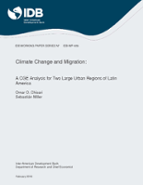Climate Change and Migration: A CGE Analysis for Two Large Urban Regions of Latin America
Date
Mar 2016
Migration is one of the strategies used by populations to adapt to natural shocks and also to respond to economic policies. Climate change will probably have an impact on the productivity of factors and on the health of the population of the Latin America and Caribbean region, triggering migrations. In addition, policies aimed at reducing emissions (like carbon taxes) will change relative prices and the remuneration of factors and, in turn, will alter the allocation of labor between urban and rural areas. This paper explores the potential quantitative relevance of those population movements using a CGE version of the Harris-Todaro model. Two paradigmatic cases are considered: i) domestic or internal migrations, focusing on the case of Sao Paulo (Brazil) and ii) international migrations, analyzing the displacement of population from Bolivia and Paraguay to Argentina.




